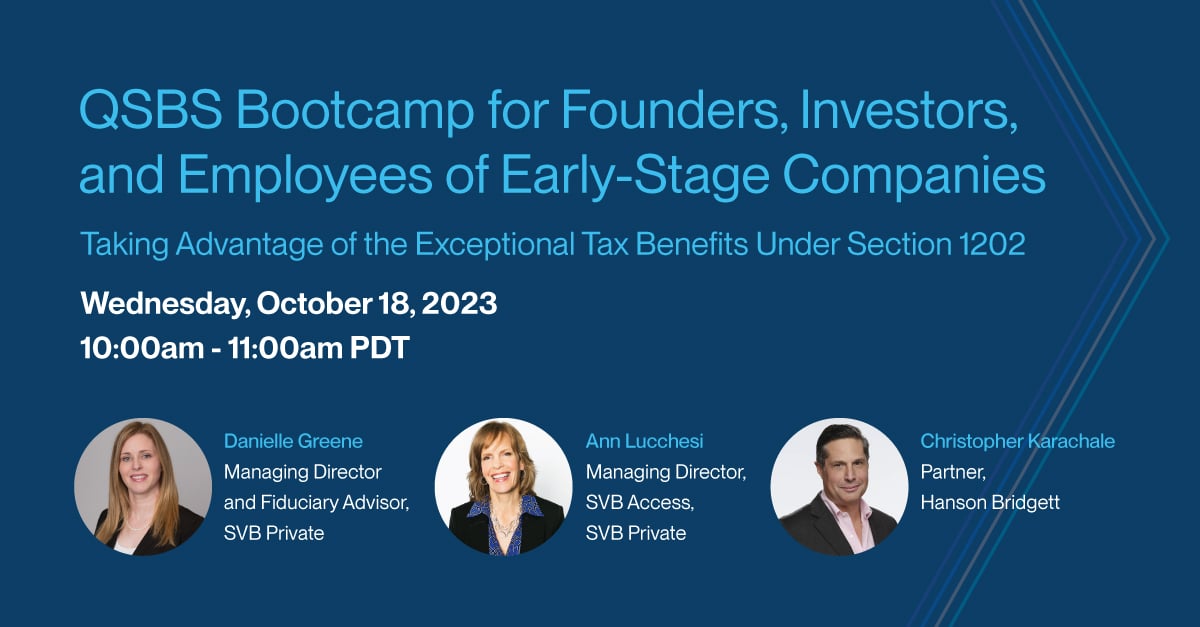Key takeaways
- If your startup takes off, the QSBS exemption can help protect you from paying taxes on up to $10 million of qualifying stock sale proceeds.
- The QSBS exemption can only be applied if the business is structured as a C corporation, but re-structuring other entity types may also provide some benefit.
- Gross assets, not valuation, determines whether a startup qualifies for the QSBS exemption when corporate stock is issued to shareholders.
Founding or joining a startup may eventually be profitable — especially with the help of a tax incentive known as the Qualified Small Business Stock exemption.
Also known as QSBS, this tax break is meant to encourage entrepreneurs and early employees to build new businesses, and for investors to fund them. If the startup takes off — and is, say, acquired — up to $10 million of stock sale proceeds are not taxed, per shareholder.
QSBS also comes with its share of requirements, complications and gray areas. SVB Private Bank sat down with Jeffrey Messerschmidt, a partner at boutique accounting firm Navolio and Tallman, in a recent conversation that laid out some of the tax break’s finer points. The bottom line: Founders, investors and early-stage employees should work with an expert early on to make the most of the QSBS exemption if applicable.
The following is an excerpt of SVB Private Bank’s conversation with Jeffrey Messerschmidt. It has been edited for length and clarity.
SVB: What should we know about QSBS? What kinds of businesses qualify for it?
Messerschmidt: If I’m meeting a new client, the first thing they always ask me is what they can do to make their tax bill go down. For top entrepreneurs and founders, there are not many slam-dunk things you can do to potentially lower your taxes — except QSBS.
When I talk to someone who doesn’t know about QSBS, I tell them that the first $10 million on the eventual sale of their company is tax free. If we do it right, it could potentially be $20, $30, $40 or $50 million tax free.
Almost every technology company I have ever dealt with can meet the standard as a qualified small business. Farms, traditional banks, law firms, CPA firms, are among businesses that don’t qualify.
SVB: Many technology and life science companies raise a lot of funding and then sit on substantial cash. They don’t want to be disqualified by exceeding the $50 million gross assets cap. Can they still qualify?
Messerschmidt: Something I hear a lot is, “My company is worth $100 million or $200 million, so we don’t qualify.” That’s actually false. Valuation doesn’t matter. Companies can be valued at $1 billion and you can still acquire qualifying shares.
All that matters is what assets are on your balance sheet on the day you acquired your shares. If you are the founder, there was nothing on your balance sheet on the day you acquired your shares, so you’re clearly under $50 million.
For investors who obtained corporate stock during the seed round or series A round, if you acquired your shares before there was $50 million on the balance sheet, then you have met step one of the requirements.
If you’re coming in at the Series B round, and let’s say you’re raising $70 million, new investors likely would not qualify.
SVB: What are some common mistakes that might disqualify an individual — or the entire company — from the QSBS exemption?
Messerschmidt: There are two major things you can do wrong. One is the corporation buying back shares of existing shareholders. Say you got funded and now you want to compensate a founder who has been underpaid by buying back his or her shares.
Believe it or not, you could be blowing QSBS not just for yourself, but for everyone in the entire company. You need to work with advisors who know the complications and can make sure you don’t go over the thresholds.
Another common mistake is buying investments on your balance sheet. For example, say a company in Europe has a similar business and you want to have a piece of it, so you take a 20 percent stake. Or if you have a couple million dollars of Apple stock on your balance sheet. That will be a problem and you will likely not qualify for QSBS.
SVB: C corporations can take advantage of the QSBS exemption. But many startups may have formed as LLCs or S corporations. What can they do in this scenario?
Messerschmidt: You get a different answer depending on whether you start as an LLC or as an S corp. It is infinitely better if you are an LLC. Say you are an LLC and you convert to a C corp. If, at that time, the fair market value of your company is $50 million or less, then the new C corp can qualify for QSBS. That is now day one of the five-year holding period for conversion.
An S corp, on the other hand, is the kiss of death for QSBS—even though it might be beneficial in the early days to be an S corp because business losses flow through your personal returns.
In this situation, we’ll go back and look at your S selection. We’ll try to poke holes to see if we can establish that you were never technically an S corp. Maybe you were always a C corp. If so, we have to go back and amend all your returns to show you were a C corp.
Otherwise, you have to restructure the company completely, and it’s not as easy and simple as if you were an LLC from the beginning.
SVB: How can you give away shares and maximize your exemption?
Messerschmidt: If a founder has a liquidity event coming up and he or she has four children, that’s just perfect. Set up an irrevocable trust for each of those kids and make gifts of qualifying shares to each trust. Each of the four trusts gets their own $10 million exclusion limit, and you retain your own $10 million. So now you can exclude up to $50 million from tax. That’s a big one to keep in mind if you already know you want to have assets going to the next generation.
SVB: What happens when you roll over funds from the sale of QSBS shares—can you invest them in another company?
Messerschmidt: Most entrepreneurs are serial entrepreneurs and they have many more ideas in their head. When you have your first liquidity event, you can use your $10 million tax exemption. Then you can take your additional proceeds above and beyond that amount and roll them into a new company. The gains on those proceeds are deferred, so you don’t currently have to pay tax on them, and the new company can have its own $10 million exclusion down the road.
It’s a nice way to fund other projects. But they have to be real projects and real businesses for this to work. In addition, the redeployment of capital from the liquidity event must happen within 60 days, so you must really plan for it.
SVB: What do you recommend in terms of record keeping to make sure that companies are properly documenting the eligibility of their shares?
Messerschmidt: QSBS has been the Wild West of tax savings, and I imagine the IRS will start auditing it more frequently. Companies typically only have a one-page checklist that supports their qualification, rather than all the underlying support they really should have. You need detailed balance sheets from inception of your holding period to the sale date. In addition, you should have a balance sheet from the day before and the day after you acquired your shares, proving that there wasn’t $50 million on the balance sheet, as well as a summary of all the equity transactions from inception proving that there has never been a redemption. A check box that says “did you have a redemption” doesn’t work.
SVB Private Bank is here to help
Taking advantage of the QSBS exemption requires careful planning and navigation, so it’s important to seek advice early. SVB Private Bank can refer you to qualified CPAs and third-party tax advisers and work with them to help you understand the guidelines, avoid the pitfalls and advise you on strategy. If implemented properly, the QSBS exemption could potentially save you from a significant tax bill — and reward you for building a successful business.














